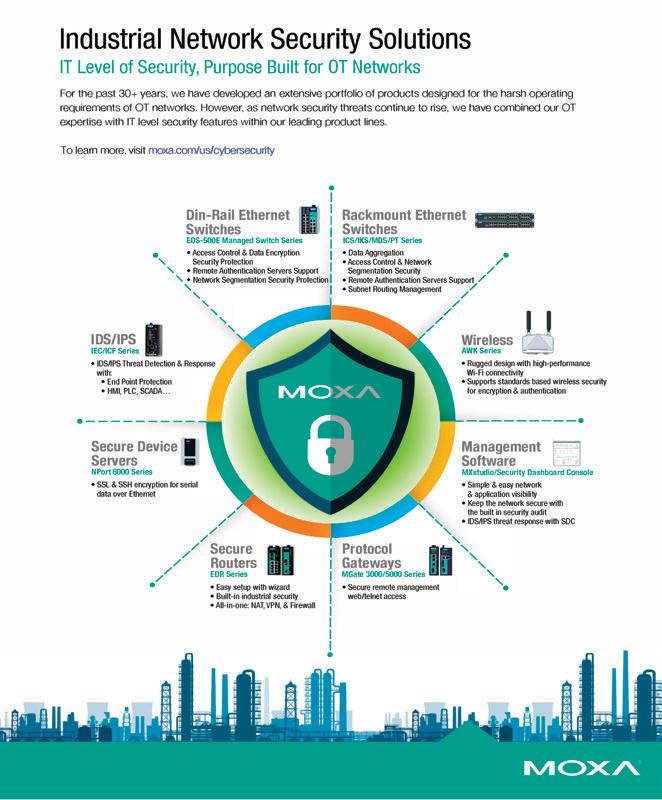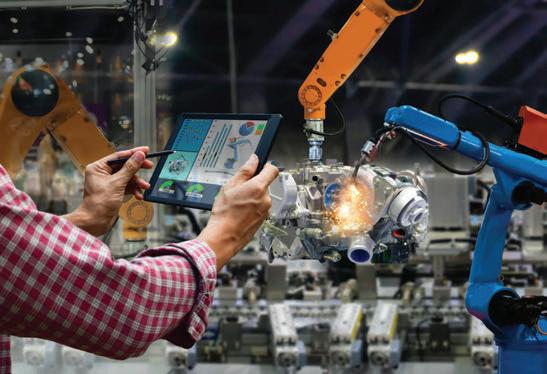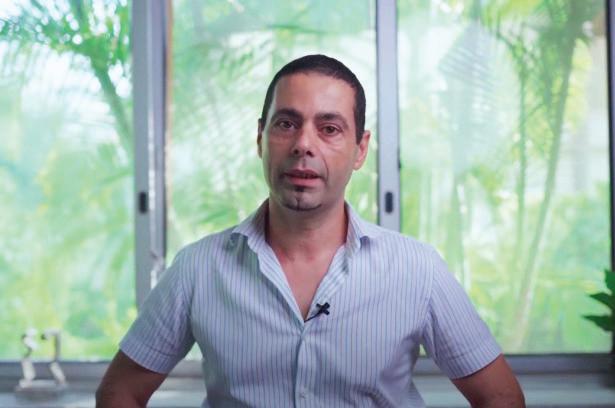
7 minute read
Acquisition Paves a New Path for PAS Global
BATCH OF IDEAS
Acquisition Paves a New Path for PAS Global
By Stephanie Neil sneil@automationworld.com sneil@automationworld.com
Senior Editor, Automation World
Mergers and acquisitions are a common occurrence in the manufacturing technology sector, but the recent news that PAS Global agreed to be acquired by Hexagon AB is interesting for a couple of reasons.
First, Hexagon, headquartered in Sweden, provides plant design and engineering software for industrial facilities. This can now be married with the PAS technology for real-time situational awareness in the control room, as well as asset management and operation technology (OT) cybersecurity risk management. This combination gives manufacturers a holistic approach to managing the entire industrial lifecycle of the plant.
Second, this acquisition was not planned. PAS CEO Eddie Habibi, who founded the Houston-based company in 1993, said he did not have a merger in mind a year ago when he initiated a process to raise investment capital as a way to expand market reach and the company’s technology footprint. “I was an engineer when I started the company and I never thought of growing it to divest it,” Habibi said, remembering the early days when the only goal was to help other engineers escape the sheer terror of dealing with control room alarms going off and not knowing if they could recover from an incident.
Catering to continuous process industries like oil and gas, chemical, pulp and paper, and power generation, PAS is positioned as an OT integrity company, providing software that reduces process safety risks to deliver trusted data for decisionmaking and optimized profitability. Several years ago, the company added technology that can prevent, detect, and remediate cyber threats—as cybersecurity and safety go hand in hand.
The cybersecurity technology landscape has so much space to grow, especially as plant equipment and devices are more interconnected. “There’s a wide portion open to be captured, which is why we went out to raise capital,” Habibi said, noting that Hexagon was one of the potential strategic investors. “When Hexagon offered to acquire 100% of PAS, we had to make a tough decision. We weren’t ready for an exit, but we want to build and take market share faster. The difference between growing organically with venture capital versus joining a world-leading software company in the industrial sector is vastly different.”
The reason PAS agreed to the Hexagon acquisition is due to the significant alignment in company cultures and complementary product portfolios, Habibi said. PAS will join Hexagon’s Process Power Marine division (PPM), which is a leading design and construction software company, and which will now have a cybersecurity business. In addition, all of Hexagon’s industry segments, including agriculture, infrastructure, mining, and more, will benefit from the PAS cyber technology. To that end, PAS extends Hexagon’s global customer footprint in the process industries.
“We will continue to offer our current products as there is no overlap between our solutions,” Habibi said. “In fact, we are looking forward to leveraging the data from each of our platforms to create new innovative and disruptive technologies that will enable digital transformation, enhance process safety, and extend our cybersecurity products.”
Terms of the agreement were not disclosed and completion of the transaction is subject to standard regulatory approvals. But once done, the PAS brand will remain and Habibi will assume a new role as founder and strategic advisor to the president of the company, a good use of his engineering expertise. “My primary focus in this role will be to spend time with customers and our internal technologists to identify technology solutions to existing and unforeseen challenges facing the industrial sector.”
While the acquisition of PAS may have been unexpected, and for Habibi, a bit bitter sweet, ultimately, it is a positive move for all involved—especially the customers of both companies.
PRODUCTION PERSPECTIVES
By David Miller dmiller@pmmimediagroup.com
Senior Technical Writer, Automation World
Today, flexibility is a requirement for all successful manufacturers, but it is particularly important for high-mix, low-volume (HMLV) manufacturers whose machinery and equipment must often handle parts and components of various different shapes and sizes, all while ensuring consistent output quality and rapid changeover capacity.
Myriad factors have contributed to the rise of these small batch manufacturers over the past several years: Supply chain uncertainty requiring less make-to-stock and more just-in-time manufacturing, increased demand for customization, and shrinking margins that require more value to be squeezed out of a single asset or piece of equipment. More recently, skilled labor shortages and social distancing requirements within plants and machine shops have only heightened the need for these manufacturers to be increasingly flexible.
Until recently, it’s been difficult for HMLV manufacturers to meet these challenges without relying on custom machine builders. In response, a growing number of flexible technologies are integrating robotics with vision and intelligence. One example of this trend is Engineered Vision’s Flex-Bot flexible feeding system, which combines a SCARA robot, machine vision system, flex feeder, hopper, robot end-of-arm-tooling (EOAT), safety system, and human machine interface (HMI) into a single product for HMLV parts feeding tasks.
By pairing an Epson precision robot with its own machine building innovation, Engineered Vision designed the Flex-Bot to be an affordable, turnkey solution for manufacturers of all sizes. Capable of handling simple to complex parts sized from 5 to 40mm, the Flex-Bot can be used with a variety of materials, ranging from plastic and rubber to metal.
According to Engineered Vision, the Flex-Bot is suitable for applications such as: mechanical and electronic assembly; medical device handling and assembly; kitting, palletization, and tray loading; and material handling. The Flex-Bot also reportedly offers ease-of-integration by allowing users to program it for any number of applications using a point-and-click interface. Moreover, the need for special tooling is eliminated, as the machine is unaffected by minor part variations, giving it a significant advantage over more typical single part feeder bowls.
“The ability of the Flex-Bot to not only process parts of multiple sizes but also to easily become a part of any existing manufacturing line truly shows how this robotic cell is at the forefront of vision flex feeding technology,” said Seth Brewer, head of business development at Engineered Vision.
Flex-bot pricing begins at $75,000 and includes programming and installation services, as well as a 1-year manufacturer warranty.
“Turnkey deployments of flexible automation systems with this capability do not exist for $75,000,” said Chad Stroud, president at Engineered Vision. “The Flex-Bot is going to help U.S. manufacturers compete in the global marketplace.”
Epson also offers its own flexible feeder system that integrates robotics, vision, and flexible material handling requirements. Read more about Epson’s Intelliflex series at awgo.to/1129.

Using Time-Sensitive Networking to Improve Productivity
By David Greenfield
Editor-In-Chief/Director of Content, Automation World
As more automation functions are performed at the edge of the network and/or in the cloud, industry experts increasingly view industrial networking as being as central to automation as the controller. This development is bringing added attention to one of the biggest networking developments of the past decade—TimeSensitive Networking (TSN).
If you’re unfamiliar with TSN, essentially it is a method of industrial networking that enables deterministic control over standard Ethernet. Its proven capabilities are why most industrial technology suppliers are adapting their products to work with TSN.
Beyond the capabilities and advantages of TSN from a networking perspective, the technology is also seen as a way of boosting productivity in specific ways for di erent industry verticals.
Thomas Burke, global strategic advisor at the CC-Link Partner Organization (CLPA), notes four specific ways TSN can help specific verticals:
Transparency and traceability for food
and beverage. Heavily regulated industries, like food and beverage, rely on process data, which must be monitored to ensure product quality and compliance with regulations or good manufacturing practices. “These data require accurate timestamps that support visibility within the network and throughout the production process, eliminating any blind spots where issues can grow unnoticed,” said Burke. “By building a fully synchronized device network, TSN can support precise timestamping for timing analysis.”
CONTINUED ON PAGE 22






